Vertical Farming Market by Growth Mechanism (Hydroponics, Aeroponics, Aquaponics), Structure (Building-based and Shipping container-based), Crop Type, Offering (Hardware, Software, Services) & Region - Global Forecast to 2029
Vertical Farming Market Size & Growth
[250 Pages Report] The global vertical farming market size is projected to grow from USD 5.6 billion in 2024 to USD 13.7 billion by 2029, registering a CAGR of 19.7% during the forecast period. The key driver that is pushing the growth of the vertical farming market is the factors in the food production system such as high population density, scarce and declining arable land, climate change, and environmental degradation. The developments in IoT, AI, and hydroponics increase efficiency and output in operation while catering to the increasing consumers’ interest in fresh and locally grown produce. Furthermore, government support for agriculture, the necessity of food security, and resource saving have further contributed to the development of the vertical farming technology as a kind of resilient agriculture.
Impact of AI/Gen AI on vertical farming market
The major use cases of AI/Gen AI in the vertical farming market share includes precision agriculture, crop optimization, robotics and automation, and image analysis. Precision agriculture incorporates AI for data interpretation for the purpose of maximizing crop production and minimizing the consumption of resources. Crop optimizers provide the optimal crop layouts for certain conditions to make the best use of space and make more money. It also plans and proves farm layouts and systems for optimization. Image analysis is used to keep track of the plant’s health, pest invasions, and growth on the plants, and this can be detected early. AI improves the functions of robots and increases their performance and work rate and increases revenues. Third, AI helps in the determination of the nature and type of crops to be grown, the right prices to charge for these crops, and to decide where exactly to transport the crops. AI and Generative AI are also largely improving and revolutionizing the vertical farming market in terms of its efficiency, sustainability, and productivity with its integration. It plays another critical role in vertical farms; AI controls light, temperature and humidity of the crops on a real time hence efficiency levels are high while wastes are low. Sustainable crop developments are even enhanced by generative AI, as it matters to farmers how, when, and to what extent their crops will grow, develop diseases, and require resources. Hence it enables practices such as precision agriculture that imply the efficient use of water and chemicals hence making it environmentally efficient. Whilst cities aim towards food autarchy, AI-driven vertical farming is a strategic course to the food problems; therefore, AI farming becomes an indispensable component for the future of food production.
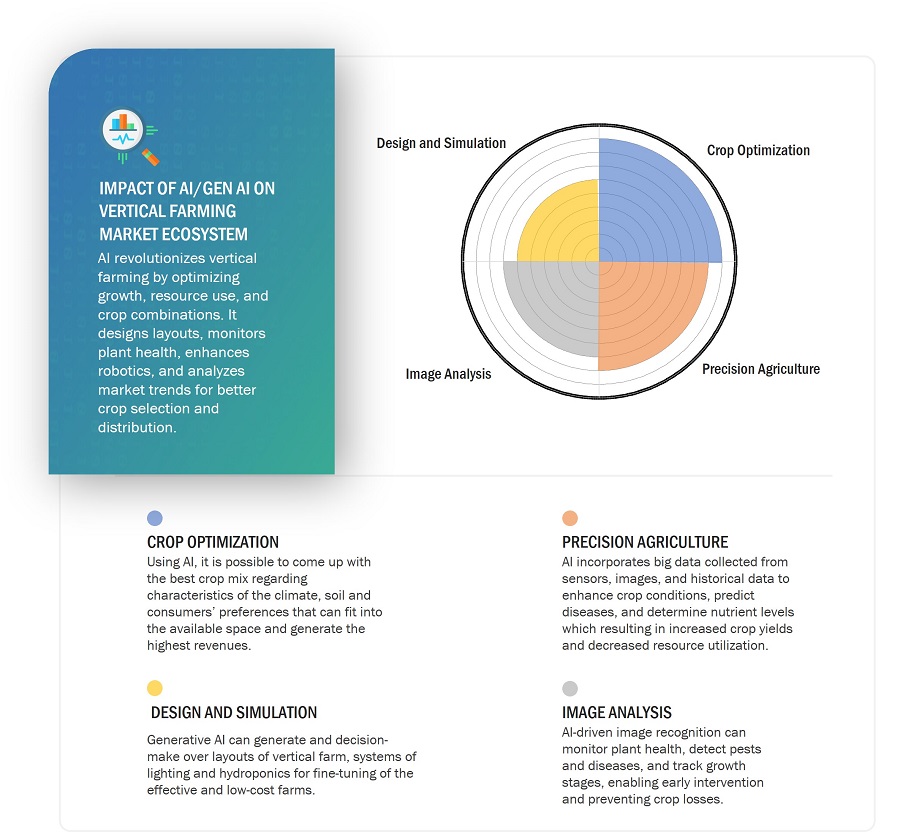
Attractive opportunities in the vertical farming market size
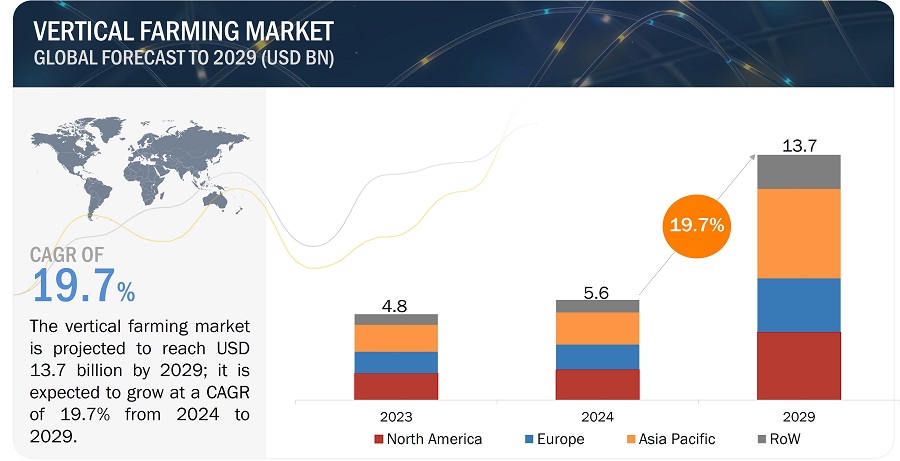
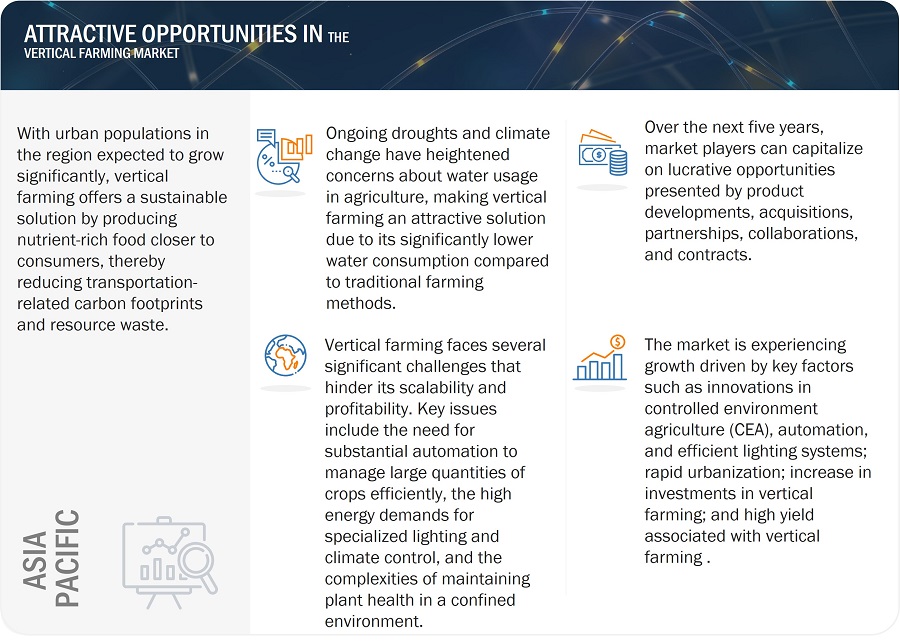
Vertical Farming Market Forecast to 2029
To know about the assumptions considered for the study, Request for Free Sample Report
Vertical Farming Market Trends:
Market Dynamics:
Driver: Year-round crop production irrespective of weather conditions
The advantage of vertical farming is that it is least affected by weather; actually, it could produce crops all through the year without having to bother over the effects of unfavorable weather on the type and appearance of the produce. Farming under secure environment rear high-quality produce and the production procedure is also predictable and programmable for the growers. Also, vertical farming properly achieves the reduction of the times of harvests and enhancement of the volume without affecting the quality or flavor of the produce, which remain fully intact. This assists the growers to have a prepared investment in the upcoming delivery timetables and offtake arrangements that are required by their customers. Besides, shifts of rainfall patterns and temperatures could reduce the farming efficiency in some countries around the world. As the climate becomes more volatile internationally and global warming being a problem all over the world, vertical farm is likely to become the ideal one. Thus, the loss due to disasters was 4 percent of the potentially produced crops and livestock globally. This relatively constitutes a significant percentage that can cause significantly interruption of production with cumulative effects on the global markets and food security. Further, vertical farming can be useful for cities or for countries for that entirely rely on imported different type of green vegetables. What is more the vertical farms do not succumb to diseases such as hurricanes, hail, drought, and snap freeze. These factors expected should increase the application of vertical farming on various levels globally.
Restraint: Limited crop variety
Vertical farming has some critical challenges when it comes to crop selection, and although it is good at growing spinach and basil, it hardly can grow crops that require some form of pollination or crops that develop remarkable root structures. Some crops like tomatoes and peppers are self-pollinated by natural insects which are difficult to mimic in a greenhouse hence requiring manual or mechanical pollination. Also, there are some types of plants that are unsuitable for growing in a hydroponic or aeroponic system because their root systems have very significant depth to penetrate hence may not be able to achieve maximum growth and production in these systems. Additionally, lights and climate differentials that various crops necessary in the production can increase energy costs as a producer tries to control the conditions. To address these issues, further studies are underway on the selection of proper cultivars for vertical farming and better ways of pollination that are critical to the diversification of crops that can be produced under those low-space and innovative farming practices.
Opportunity: Reduced environmental impact from agriculture by the adoption of vertical farming
Vertical farming is significant in decreasing the repercussions of the ecological consequences of agriculture. It means that one is able to cultivate the same or more crops using a lesser proportion of water as compared to using more water and producing the same yield. It also eliminates chemical, and pesticides employed to cultivate crops and reduces the transportation cost. In vertical farming everything is done naturally, that is, it is an overall organic process. It drastically reduces the use of chemicals and promotes the application of natural products in this growth mechanism of vertical farming like using fish to produce nutrient solutions for plant in the form of waste in an aquaponics system. Additionally, since vertical farming is done in a controlled environment, they are protected from all sorts of hazardous insects, thus no use of pesticide. Without having to implement methods that in the process exclude burning of field, grass or any kind of waste, it assures production of healthy and quality production to its consumers. In this regard, it is anticipated to open a new window of opportunities for the players in the vertical farming industry. Irrigation is the largest user of fresh water and this ranges between 70-80% of freshwater usage on the global stage. Also, over 2 billion individuals are worldwide affected by water scarcity. Thus, vertical farming has, in essence, been able to cut water usage by 95% and sometimes by 99%. For instance, the water usage for growing one kilogram of tomatoes in the field ranges from 60 to 200 liters. On the other hand in vertical farms, to yield the same amount of tomatoes, 2 to 4 liters of water suffices only.
Challenge: High start-up costs
The first issue that is encountered in vertical farming is the high capital costs that any farmer or company that wants to venture in indoor vertical farming faces. It needs a large amount of capital to build vertical farms and the costs of operating vertical farms are high. Consequently, they established that vertical farming was costly than the conventional farming methods. Management of the environment within the buildings like light, climate, pollination and the placement of the plants are important ideal for a vertical farm. . The farmers are subjected to high levels of initial costs as far as the devices and equipment for vertical farming is concerned. The equipment, sensors and lighting systems are costly and have to be purchased apart along with the farming equipment. When establishing all the systems of vertical farm, the management devices, the farm monitoring and sensing devices, as well as the total system interface, are also installed. Moreover, if such systems and components were brought from other countries, the escalation of the setup cost would be even worse. This is one the major factors restraining the growth of the vertical farming market This has been prompted by some of the following reasons.
Vertical Farming Market Ecosystem
Key companies in this market include well-established, financially stable system manufacturers and crop producers. Prominent companies in this market include Signify (Netherlands), Freight Farms (US), AeroFarms (US), Sky Greens (Singapore), Spread (Japan), Plenty (US), Valoya (Finland), Osram (Germany), Everlight Electronics (Taiwan), and Heliospectra AB (Sweden), among others.
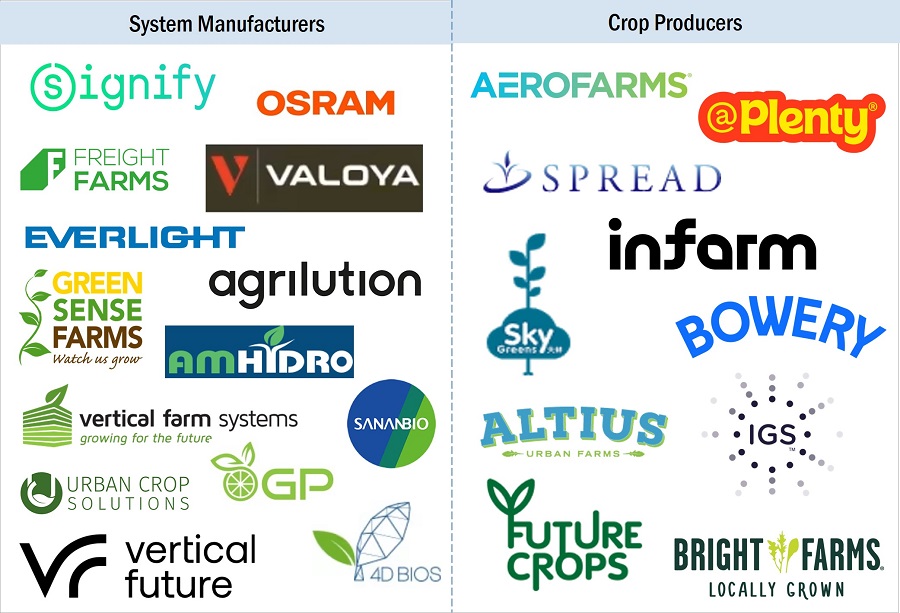
By Offering, service segment likely to exhibit the highest CAGR during the forecast period
The need to automate processes and employ different technologies that enable the efficiency of organizations’ activities is the foremost reason behind the service offering. This means that, while, as the sophisticated systems of a vertical farm include AI monitoring, robotic harvesting, and Automated climate control services, the need to get both managed services and system Integration is inevitable. Most of these services assist in the running of the farm and contribute to, or act as substitutes to labor, while at the same time increasing on agricultural productivity. Also, the modern trend of sustainable agriculture and concerns of resource consumption push vertical farms to develop complex and effective service solutions for resource consumption. This is boosted by the increasing urbanization and the push for localized food production, which makes the service segments as a critical element in advancing of vertical farming.
By mechanism, hydroponics is expected to account for largest share between 2024 and 2029.
Hydroponics is a methodology of raising plants without soil, using only water and nutrients and, hence, providing food production principles that are very efficient. It is less input intensive especially space and water as compared to conventional farming hence it is a good option. Besides, by means of hydroponics it is possible to produce food throughout the year without reference to the climate changes. Hydroponics is preferred by commercial growers mostly because it has several advantages that are propitious to vertical farming. First of all, it makes the process effective by minimizing water consumption and the occupied area. Secondly, it provides growers with more substantial discretion concerning the environmental conditions of the hydroponic system at the growers’ sites. Third, hydroponics produce very quality crops that are suitable for the market as emphasizing the following benefits. Finally, it leads to sustainability of the natural recourses since organic farming offers a more natural way of growing food crops than the conventional methods. Such benefits have rendered hydroponics as the most suitable form of farming among commercial growers with the aspects of vertical production.
Asia Pacific is estimated to have largest market share in the global market in 2023
It is estimated that the Asia Pacific region will have the highest growth rate in the vertical farming considering the fact that the growth rate in this region is expected to rise at a faster pace as compared to other regions in the globe. Some of these are born from factors such as high population density in the urban areas, degradation of arable land due to the environment, and the current trends in Healthy Eating, Natural and Organic Foods that notably apply minimal pesticide use. Present day countries such as China, Japan and India among others have shifted focus to such innovative technologies on agriculture, farming techniques such as hydroponics and aeroponics because of their high yields in the context of population density. Besides, automation and IoT also have crucial participation in how the agriculture practice is implemented and improved organizational effectiveness causing it to be an efficient model of vertical farming to meet the population’s increasing food needs without being detrimental to the environment. Considering the fact that the process of sustainable farming is in practice, Asia-Pacific region is expected to share the expertise and examples of vertical farming along with innovations that are expected to shape the market.
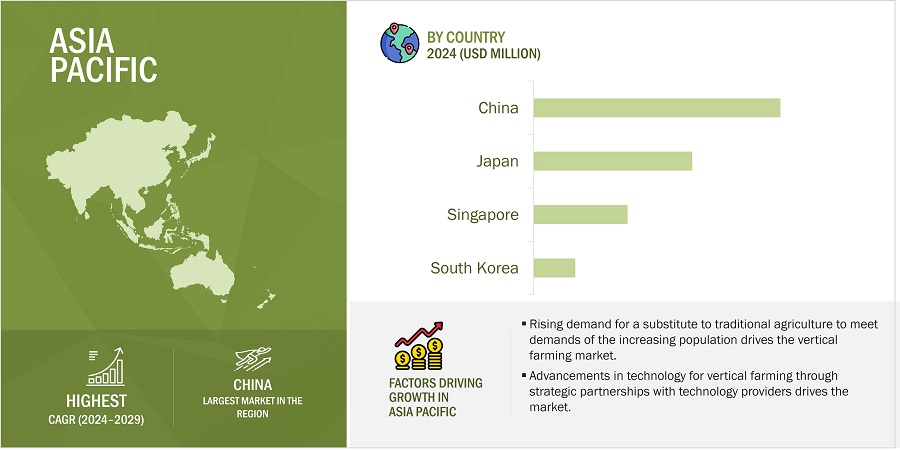
Vertical Farming Market by Region
To know about the assumptions considered for the study, download the pdf brochure
Key Market Players
Signify (Netherlands), Freight Farms (US), AeroFarms (US), Sky Greens (Singapore), Osram (Germany), Spread (Japan), Plenty (US), Valoya (Finland), Everlight Electronics (Taiwan), and Heliospectra AB (Sweden) are some of the key players in the vertical farming companies.
Get online access to the report on the World's First Market Intelligence Cloud
- Easy to Download Historical Data & Forecast Numbers
- Company Analysis Dashboard for high growth potential opportunities
- Research Analyst Access for customization & queries
- Competitor Analysis with Interactive dashboard
- Latest News, Updates & Trend analysis
Request Sample Scope of the Report
Get online access to the report on the World's First Market Intelligence Cloud
- Easy to Download Historical Data & Forecast Numbers
- Company Analysis Dashboard for high growth potential opportunities
- Research Analyst Access for customization & queries
- Competitor Analysis with Interactive dashboard
- Latest News, Updates & Trend analysis
|
Report Metric |
Details |
|
Market Size Availability for Years |
2020–2029 |
|
Base Year |
2023 |
|
Forecast Period |
2024–2029 |
|
Forecast Units |
Value (USD) |
|
Segments Covered |
By offering, growth mechanism, structure, crop type, and region |
|
Geographies Covered |
North America, Europe, Asia Pacific, and RoW |
|
Companies Covered |
Signify (Netherlands), Freight Farms (US), AeroFarms (US), Sky Greens (Singapore), Spread (Japan), Plenty (US), Valoya (Finland), Osram (Germany), Everlight Electronics (Taiwan), and Heliospectra AB (Sweden) are some of the key players in the vertical farming market. |
Vertical Farming Market Highlights
This research report categorizes the vertical farming market share based on offering, technology, vertical, implementation, application, and region.
|
Segment |
Subsegment |
|
By Offering |
|
|
By Growth Mechanism |
|
|
By Structure |
|
|
By Crop Type |
|
|
By Region |
|
Recent Developments
- In June 2023, Signify has teamed up with Siemens, a technology firm, for the provision of IT services in vertical farming. It says the idea is to see how technology can be used to control and manage processes including climate, lighting, planting, and watering for 80 Acres Farm, an Ohio based chain that grows crops indoors and supplies local supermarkets and retailers.
- In May 2023, Amazon Fresh expanded its agreement with AeroFarms, where AeroFarms is set to become a major provider of hydroponic greens to Amazon Fresh.
- In February 2023, ams OSRAM signed a deal with Revolution Microelectronics, a designer of the controlled agriculture environment based in the United States of America.
- In February 2023, Realty Income Corp entered a deal with Plenty Unlimited Inc plan involved the construction of farming space that will be leased fully to Plenty Unlimited for up to an investment of one billion US dollars.
- In May 2022, ams OSRAM launched the OSLON Optimal series of LEDs that consists of the latest 1mm2 chip ideal for horticulture lighting.
- In August 2021. The deal for this partnership was signed between AeroFarms and Nokia Bell Labs in order to fuse both companies’ experience and enrich their capacities in networking, as well as in autonomous a system, integrated machine vision and machine learning technologies to examine plant interactions on the most fundamental levels.
- In August 2021. AeroFarms declared that operated in the Middle West region through a project with WWF and STLCEA to present the best practices to reduce the environmental impacts of vertical farming indoors.
Frequently Asked Questions:
What is the current size of the global vertical farming market?
The vertical farming market is projected to reach USD 13.7 billion by 2029 from USD 5.6 billion in 2024, at a CAGR of 19.7% during forecast period.
Who are the winners in the global vertical farming market share?
Companies such as Signify (Netherlands), Freight Farms (US), AeroFarms (US), Sky Greens (Singapore), Spread (Japan), Plenty (US), Valoya (Finland), Osram (Germany), Everlight Electronics (Taiwan), and Heliospectra AB (Sweden), fall under the winner’s category.
Which region is expected to hold the highest market share?
In recent years the Asia-Pacific region has been recognized as the fast-growing vertical farming market stimulated by the increasing rate of urbanization, reduction of the arable land, and growing consumers’ need for fresh and certified organic food. China, Japan and India among others have aimed at venturing into hydroponics and aeroponics systems. Through automation and incorporation of IoT, demands for food production are met and so is the use of vertical farming. As the populace becomes informed of sustainable farming practices, the region is expected to be ahead in the specifics of vertical farming.
What are the major drivers and opportunities related to vertical farming market share?
Some of the significant factors that lead to the development of vertical farming include; urbanization, shortage of viable land, climatic change, and consumers’ concern with organic food production. Potential benefits include IoT and AI, optimization of productivity, and the subject geo-urban environments’ ability to cultivate produce locally to cut down on the transportation and pollution of foods.
What are the major restraints and challenges associated with the market?
Some of the significant limitations and impediments in vertical farming consist of a high cost of installation and implementation, elevated energy usage, restricted adaptable types of crop, and technicality as well as professional labor necessity. Also, competition from the markets for the crop and local practices of farming challenges the adoption of the new practice.
To speak to our analyst for a discussion on the above findings, click Speak to Analyst
The study involved four major activities in estimating the size of the vertical farming market. Exhaustive secondary research has been carried out to collect information on the market, the peer markets, and the parent market. Both top-down and bottom-up approaches have been employed to estimate the total market size. Market breakdown and data triangulation methods have also been used to estimate the market for segments and subsegments.
Secondary Research
Revenues of companies offering vertical farming systems have been obtained from the secondary data available through paid and unpaid sources. The revenues have also been derived by analyzing the product portfolio of key companies, and these companies have been rated according to the performance and quality of their products.
In the secondary research process, various sources have been referred to for identifying and collecting information for this study on the vertical farming market. Secondary sources considered for this research study include government sources, corporate filings, and trade, business, and professional associations. Secondary data has been collected and analyzed to arrive at the overall market size, which has been further validated through primary research.
Secondary research has been mainly used to obtain key information about the supply chain of Vertical farming systems to identify key players based on their products and prevailing industry trends in the Vertical farming market by offering, type, panel size, location, vertical, and region. Secondary research also helped obtain market information- and technology-oriented key developments undertaken by market players to expand their presence and increase their market share.
Primary Research
Extensive primary research has been conducted after understanding and analyzing the current scenario of the Vertical farming market through secondary research. Several primary interviews have been conducted with the key opinion leaders from the demand and supply sides across four main regions—North America, Europe, Asia Pacific, and the Rest of Europe. Approximately 25% of the primary interviews were conducted with the demand-side respondents, while approximately 75% were conducted with the supply-side respondents. The primary data has been collected through questionnaires, emails, and telephone interviews.
After interacting with industry experts, brief sessions were conducted with highly experienced independent consultants to reinforce the findings from our primary. This, along with the in-house subject matter experts’ opinions, has led us to the findings as described in the remainder of this report. The breakdown of primary respondents is as follows:
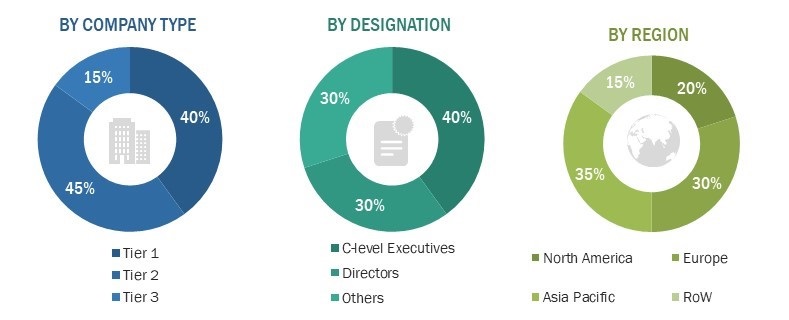
To know about the assumptions considered for the study, download the pdf brochure
Market Size Estimation
The bottom-up procedure has been employed to arrive at the overall size of the vertical farming market.
- Company-wise revenues generated through the sale of lighting, hydroponic components, climate control, sensors, software, and services have been estimated.
- Break down of the sales data of key companies offering products for vertical farming has been estimated, and percentage splits have been derived.
- The market size of each offering segment i.e. hardware, software, and services have been estimated.
- The global vertical farming market size has been arrived after adding market estimates from hardware, software, and services segment .

The top-down approach has been used to estimate and validate the total size of the Vertical farming market.
- MarketsandMarkets has considered top-line investments and R&D expenditure in the vertical farming ecosystem.
- Information related to the revenue generated in the vertical farming market through different segments—growth mechanisms, structures, and geography—has been collected.
- Multiple on-field discussions with key opinion leaders have been carried out across major companies involved in the vertical farming market to validate their market position.
- Geographic splits have been estimated using secondary sources based on numerous factors, such as the number of players in a specific country and region and the range of offerings each company serves.

Data Triangulation
After arriving at the overall market size-using the market size estimation processes as explained above-the market has been split into several segments and subsegments. To complete the entire market engineering process and arrive at the exact statistics of each market segment and subsegment, data triangulation and market breakdown procedures have been employed, wherever applicable. The data has been triangulated by studying various factors and trends from the demand and supply sides in the vertical farming market.
Market Definition
Vertical farming is a method of cultivating crops on a vertical stack in an urban setup. In vertical farming, an artificial environment is created inside a facility, using technology, which helps plants grow with high nutritious content in a short period compared with traditional farming. Growth, productivity, and quality of plants depend on technologies, such as climate control, air purification, lighting, and pump and irrigation systems. Vertical farming can be done using three different growth mechanisms: hydroponics, aeroponics, and aquaponics. The vertical farms can be of different types, such as building-based, shipping container-based, and deep farms. The output of the vertical farms is multifold compared with conventional farming in the same area of a farm, as crops are grown using vertical stacks in vertical farms in a controlled environment agriculture technology, increasing the quantity of produce, while in conventional farming, crops are planted at a single level, making vertical farming an efficient farming technique.
Key Stakeholders
- Raw material vendors
- Original technology designers and suppliers
- Raw material and component suppliers
- Vertical farming system manufacturers
- Assembly manufacturers
- System integrators
- Assembly and packaging vendors
- Technical universities
- Research institutes and organizations
- Market research and consulting firms
- Original equipment manufacturers (OEMs)
Report Objectives
- To define, describe, and forecast the vertical farming market by growth mechanism, structure, and offering, in terms of value
- To define, describe, and forecast the vertical farming market by crop type in terms of volume
- To describe and forecast the market for various segments, with respect to four main regions, namely, the North America, Europe, Asia Pacific, and the RoW(South America, and MEA), in terms of value
- To provide detailed information regarding the drivers, restraints, opportunities, and challenges that influence the market’s growth
- To analyze the impact of generative artificial intelligence (Gen AI) on the vertical farming market.
- To provide a detailed overview of the vertical farming market’s value chain, along with the ecosystem, technology trends, use cases, regulatory environment, and Porter’s five forces analysis for the market
- To analyze industry trends, pricing data, patents and innovations, and trade data (export and import data) related to the vertical farming systems
- To strategically analyze the micro markets with respect to individual growth trends, prospects, and contributions to the total market
- To strategically profile the key players and comprehensively analyze their market share and core competencies
- To analyze opportunities for stakeholders and provide a detailed competitive landscape of the market
- To analyze competitive developments such as product launches/developments, contracts, collaborations, partnerships, agreements, acquisitions, expansions, and research and development (R&D) activities carried out by players in the vertical farming market
Available customizations:
With the given market data, MarketsandMarkets offers customizations according to the specific requirements of companies. The following customization options are available for the report:
- Detailed analysis and profiling of additional market players based on various blocks of the supply chain




 Generating Response ...
Generating Response ...







Growth opportunities and latent adjacency in Vertical Farming Market
We want to establish a pilot project for vertical farming in Germany
I want to know the breakdown of the categories of the vertical farming market. So for instance, container farms, vertical greenhouses, instrument suppliers etc...
I am doing a report on vertical farming and believe this PDF would be a great asset in finding useful information.
UK protected edibles conventional producer, looking to enter VF as a primary producer. I am also applying for a Nuffield Scholarship to study VF in more detail so your report would be very useful. Thanks.